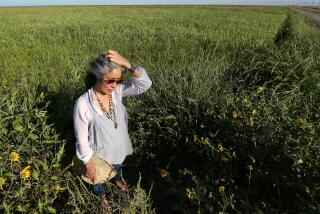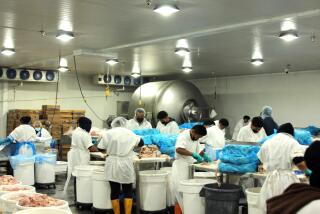Animal Feed Now Health Food : Rice Bran Gets New Life, Thanks to Torrance Firm
Rice bran--long consigned to feed for cattle and pigs--can now be rendered economically fit for human consumption, thanks to technology developed by Brady International of Torrance.
Brady International announced shipment to two California mills Wednesday of its rice-bran processor, which resulted from a government program aimed at making better use of the world’s present supply of rice. The development could also improve nutrition in this fiber-conscious country as well as abroad.
Brady developed the processor, which stabilizes rancid-prone rice bran, in conjunction with the Agriculture Department. The machines are produced under contract with Brady by ASI Controls in Houston.
Eight of the machines are heading from Houston for Comet Rice’s big mill in Maxwell, Calif., north of Sacramento. An earlier generation of Brady processors has been producing rice bran on a market-testing basis for more than a year in a joint venture with Comet, a subsidiary of Los Angeles-based Erly Industries.
The Maxwell mill has produced stabilized rice bran for sale to Japan, where an oil rich in vitamin E is extracted for cooking and for use in skin creams. Pacific Rice Products in nearby Woodland has also been buying bran for its new line of Perky’s rice-bran cereals and Vita Fiber concentrate, which now are being distributed nationally, Pacific Rice President Curt Rocca said.
Government Support
Six other processing machines are on the way to the Woodland mill operated by the Rice Growers Assn. of California, a milling and marketing cooperative headquartered in West Sacramento. RGA has bran customers in Taiwan and Japan, spokesman Jack Kenward said.
Patricia Mayhew, co-founder and executive vice president of Brady International, patent owner of the stabilizing process, said the U.S. Agency for International Development and the USDA have supported development work in an effort to overcome rice bran’s tendency to become rancid within hours of its separation from the rice kernel.
While both agencies view rice bran as a potentially valuable new source of nourishment in the rice-based diets of many Third World countries, Mayhew also sees a big potential U.S. market as well.
“Rice bran is such a wasted product,” she said in an interview. “With the new surgeon general’s report that suggests each American ingest 40 grams of fiber a day, we are going to have to add 5 billion pounds of edible fiber to the American food system. This is a way to help do that.”
Brady also has entered into joint ventures with mills in India, where a dozen of the fully automated machines are being shipped, and the company is negotiating with China, Mayhew said.
Robin M. Saunders, research leader of the food quality research unit of USDA’s Western Regional Research Center in Albany, Calif., said stabilizing rice bran has been a high-priority research project for at least 25 years.
India alone holds a huge potential for consumption of rice bran, he said. “But the best potential is yet to be realized. That is China, which is negotiating with Brady. China represents, with India, more than 50% of the world’s rice supply. There’s a huge, huge potential for market development.”
As to the nutritional value of rice bran among other grains currently riding the nutritional bran wagon, Saunders said some studies show that rice bran oil itself lowers serum cholesterol and that rice bran itself may lower it. “No one can really say for sure,” he said, “because we don’t have that study yet in humans.” One is about to get under way in Mississippi, he said. “We’re sort of keeping our fingers crossed on that.”
More to Read
Inside the business of entertainment
The Wide Shot brings you news, analysis and insights on everything from streaming wars to production — and what it all means for the future.
You may occasionally receive promotional content from the Los Angeles Times.










